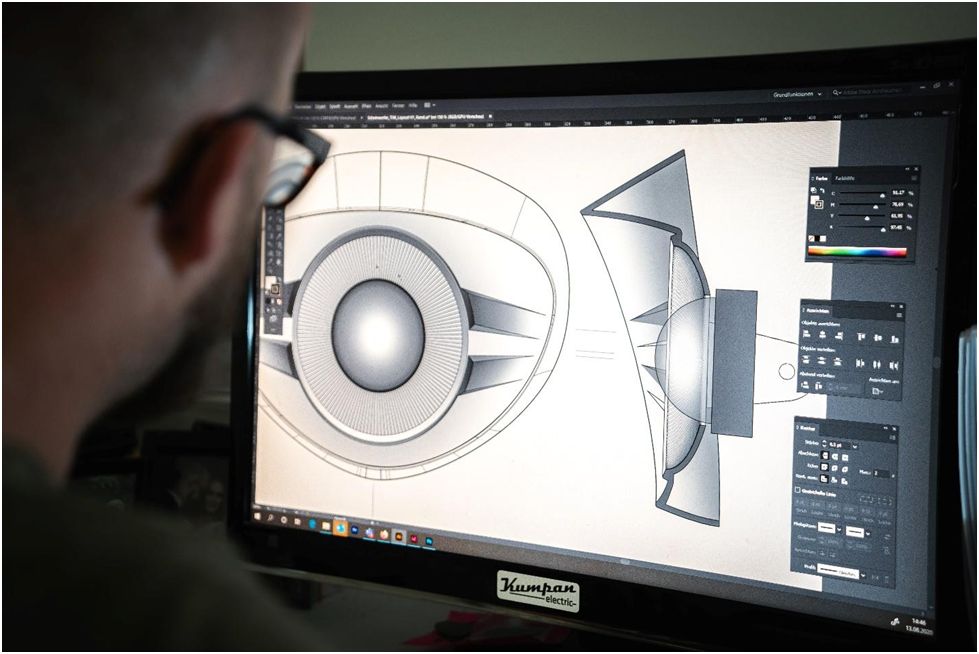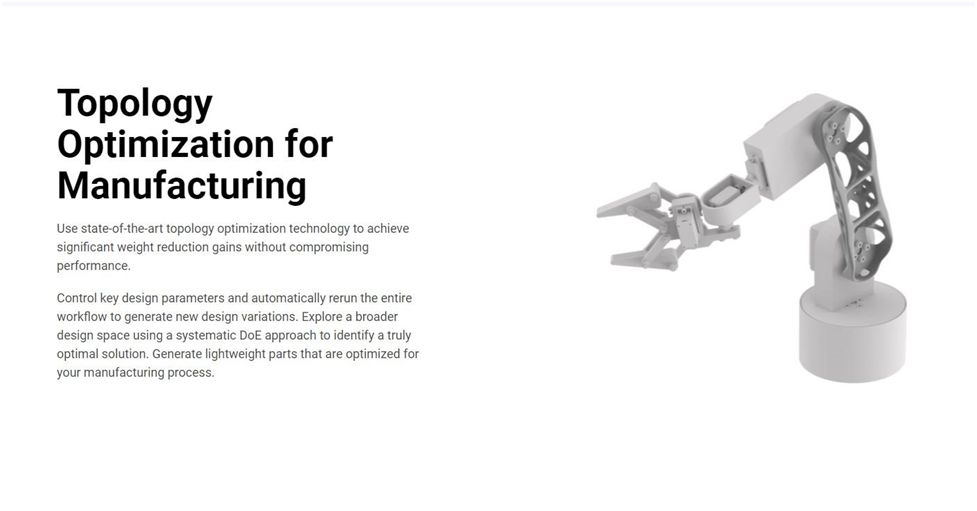An engineer’s CAD program often features images of organic and exotic-looking part shapes. Does it appear as though the engineer has designed it on a whim rather than taking a disciplined approach? Well, it’s topology optimization working behind the veil.
These shapes are generated by a computer algorithm’s logic and not the engineer’s. A topology optimization software, quite literally, picks up the 3D design space and models the material into it to achieve a highly efficient design. Topology optimization pays no regard to the part’s aesthetics, conventional techniques, and other common design constraints.

Table of Contents
What is Topology Optimization?
Topology optimization is the process of optimizing the layout and structure of material within the existing space of a 3D design for a set of user-defined rules. The goal here is system performance maximization through mathematical modeling and optimization for constraints, boundary conditions, and external forces.
Topology optimization has various applications throughout product design, but it’s dominantly used for size and shape optimization in the design phase.
The reason? Naturally-occurring free forms through topology optimization can be challenging to manufacture via conventional methods of manufacturing. However, topology optimization-generated designs can be directly used as input into 3D printers, thanks to advancements in additive manufacturing.
How Does Topology Optimization Work?
Topology optimization requires an existing model. Engineers may decide to optimize the full part or just an element inside it. The area that the engineer is focusing on is referred to as the design space.
Topology optimization creates a simple design space mesh using finite element analysis (FEA). Next comes an analysis of this mesh for strain energy and stress distribution. This provides system information regarding the loading that each section can handle.
Material distribution for some sections of the design may already be optimal, while other sections may require some trimming. The finite element method helps mark the sections with low stress levels and strain energy. After the design has been scanned for inefficient sections, the objective function begins to remove unnecessary material from the design.
As the system trims the excess material, it will also check how the removal is affecting the overall structure. If at any point during the process the structure’s integrity is compromised, the process is terminated and the region’s material is retained.
Engineers set the percentage of material intended to be removed before the topological optimization algorithm is run. For instance, they could set a material reduction target of 30 percent.
The excess material is removed by the system in stages. The structure is checked for stress levels at each stage through reiteration of element distribution, and this continues until the target percentage set by the engineer is reached.
Where is Topology Optimization Used?
Topology optimization is turning heads across industries. This makes perfect sense, too. Who wouldn’t want the incredible benefits it offers?
Granted, it comes with a hefty price tag, but the pros far outweigh this one con. Industries like aerospace, automotive, and medical in particular are keen on using this mathematical modeling method in their designing. Let’s look at how these industries use topology optimization.
1. Aerospace industry
Ever since the first airplane was built, the industry has been striving to minimize the mass of an aircraft without affecting its strength. Topology optimization allows detailed analysis of components of an aircraft, thereby allowing engineers to identify and eliminate excess component mass. This translates to higher fuel efficiency and saves airline companies a significant amount of money.

These benefits also carry through to other aerospace designs such as rockets and satellites. Topological optimization allows engineers to minimize support structures and design lightweight components without any reduction in strength.
2. Automotive industry
Some companies in the industry are leveraging the power of topology optimization for designing machinery and structural components. These companies have managed to reduce the body skeleton’s mass while retaining, and even increasing in several cases, the original product’s strength.
Interestingly, steel has started to find more applications in addition to adhesives and composites. This is because of the possibility that more complex lattice structures could be created using additive manufacturing.
3. Medical industry
The most common use case of topology optimization in the medical industry is the creation of implants and prosthetics. The algorithm can be used to create parts that are optimized for the patient’s bone density and stiffness. Moreover, the algorithm can also factor in the anatomy of the patient and the activity level and load applied of the designed part.
Importance of topology optimization
A topology optimization software brings a wide range of benefits. The use of topology optimization can empower engineers to stay ahead of the curve and compete in an already highly competitive environment.

1. Topology optimization minimizes the part’s weight
Any mechanical part that an engineer has designed will likely weigh more than it should without topological optimization. A structure that weighs less, in addition to minimizing the cost of material, also optimizes the consumption of manufacturing resources.
Generally, the lighter a moving part is, the less friction it generates, and the lesser energy it requires for being put in motion. The benefits also carry through into the supply chain because lightweight parts are relatively easy and cheap to transport.
An excellent, real-world example is how GE reduced an engine bracket’s weight by 84 percent using topology optimization. Although the savings on a per-part basis seem minuscule, it translated to $31 million in savings for the airlines because of better overall energy efficiency.
2. Topology optimization fast-tracks the designing process
The performance expectations and design constraints are identified and addressed early on during the conception phase. Therefore, the process takes far less time with topology optimization to complete the final design.
Topology optimization shortens the product development cycle by eliminating unnecessary human involvement in the designing process. Engineers can use AI-powered topology optimization tools for generating every design that is viable under the constraints added by the engineer.
The ability to fast-track the designing phase translates to a shorter time-to-market. This can be a critical factor for some industries, especially if the company is introducing a new product in a market that is fiercely competitive.
3. Topology optimization provides a wider range of design options
Topology optimization provides a lot of room for product innovation. It removes the design limitations common in traditional design systems. Topology optimization provides ample options for product designs owing to the power of Artificial Intelligence and Machine Learning.
The product’s design, then, is only left with constraints that the designer manually puts in. What’s more, designers can choose from excellent designs readily, consequently saving time and effort.
4. Topology optimization helps achieve improved designs more quickly
Traditional development techniques take more time and also pose a lot of challenges when working on complex designs for industrial products. Topology optimization addresses these roadblocks and allows engineers to quickly achieve a viable design.
This is done through machine learning. Machine learning generates viable designs at lightning-fast speeds. That’s not it, machine learning also improves this design generation process over time. The software applies its learning from historical data with every design iteration that it goes through. This allows identification and optimization of the design’s vulnerable points.
Topology optimization software removes the obstructions common to its traditional counterpart, CAD. It allows engineers to develop complex structures that they initially believed were impossible to develop. All that engineers require to convert the design into reality then is a 3D printer.
5. Topology optimization maximizes performance
The involvement of organic and complex shapes in a part’s optimal design can often feel unintuitive. As mentioned earlier, topology optimization algorithms ignore factors such as aesthetics and even violate some generally followed design rules like uniform thickness. However, this trade-off is in favor of superior performance for the part.
6. Topology optimization is good for the environment
To begin with, topology optimization minimizes unnecessary wastage of material. The algorithm has the capability to create building systems that are sustainable while still confirming with sound structural logic. What’s more, as seen in GE’s case, topology optimization’s ability to design lightweight products translates to increased fuel efficiency.
World leaders are restructuring laws to make industries environment-friendly. The pressure is building up on corporations and they’re constantly searching for sustainable alternatives. Topology optimization can subsidize the efforts of manufacturers across industries as they make the shift to becoming sustainable.
Topology Optimization is Here to Stay
Though topology optimization is excellent at optimizing designs, it can sometimes feel uncontrollable, especially for beginners. Nevertheless, control of various factors can help derive a more favorable outcome from the model.
For instance, adding a restriction on design space’s member size or the final model’s extrudability. Engineers can even control the material removal target percentage for controlling the algorithm’s alacrity that it will use for optimizing the part.
Businesses, as well as their consumers, are starting to ask for solutions that are more effective, more efficient, faster, and environmentally friendly. Engineers and product teams can leverage the power of topology optimization to unlock these benefits. Fortunately, topology optimization is starting to become more accessible by the day.

Arjun is a B2B writer specializing in engineering, SaaS, and technology. He writes articles for businesses across the globe, including the SEO agency, Skale. Arjun has five years of writing experience across verticals.